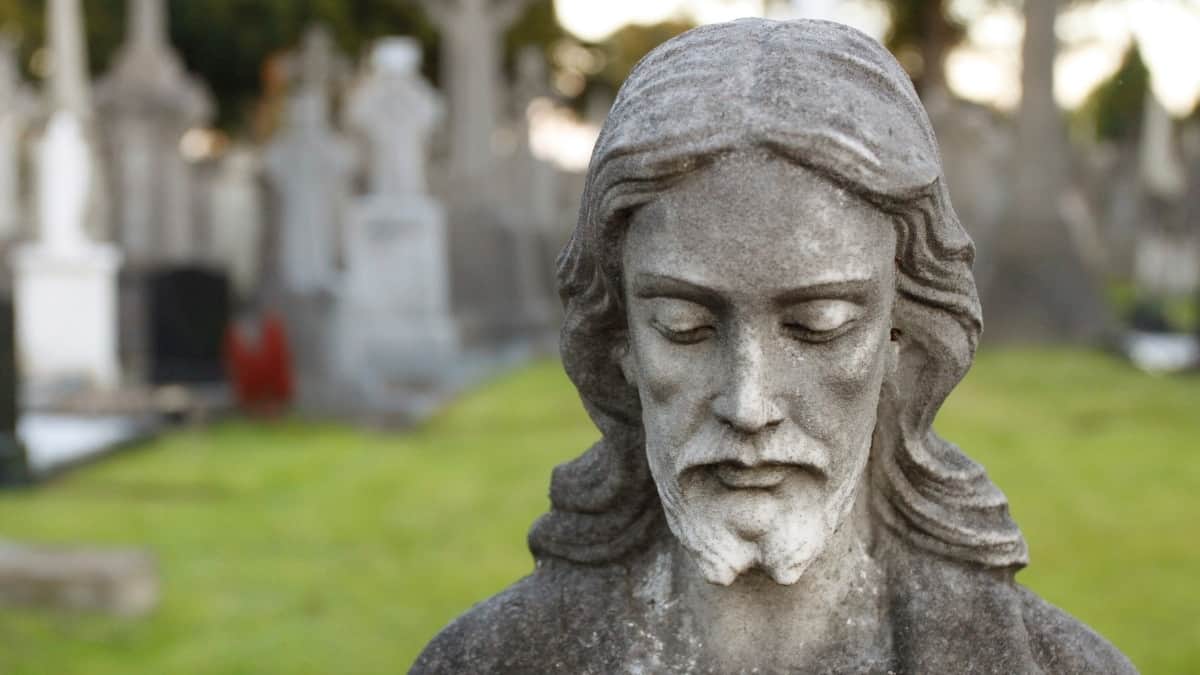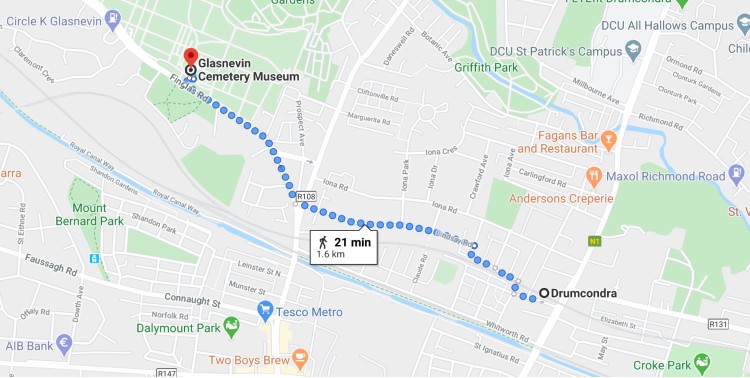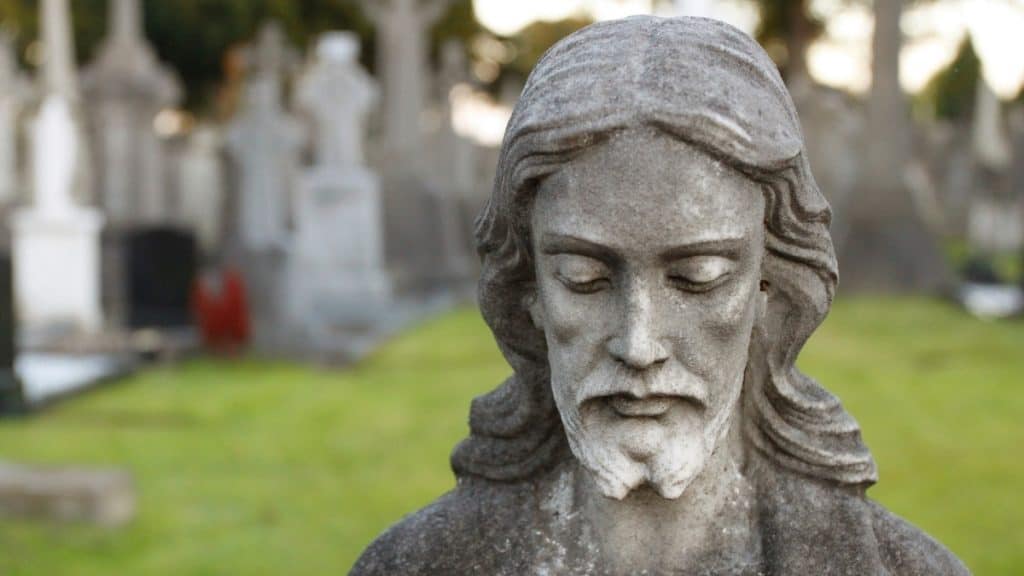
Glasnevin Cemetery and Museum is an award-winning Dublin attraction and gets more than half a million visitors annually.
Tourists visit Glasnevin to hear fascinating stories of those laid to rest in the Cemetery, see the stunning collection of statues and headstones, and to understand the history of modern Ireland.
It is one of the most beautiful and historically significant sites in the whole country.
In this article, we share everything you must know before booking your Glasnevin Cemetery tour.
Top Glasnevin Cemetery Tickets
Table of Contents
How to reach Glasnevin Cemetery
Glasnevin Cemetery is on the Finglas Road, 2.5 km (1.5 Miles) from Dublin’s city center.
Bus to Glasnevin
Bus Numbers 4, 9, 40, 83, and 140 can take you to Glasnevin Cemetery Museum.
If you are traveling from Dublin City Center, board one of these buses from O’Connell Street.
There is a bus every 8 to 10 minutes.
By Hop-On Hop-Off Bus
You can also use the Dublin Hop-On Hop-Off tour bus to get to the Glasnevin Cemetery.
Between the City Sightseeing’s bus tour and Big Bus Open-Top bus tours, we recommend the latter because of their better ratings.
In Dublin, these HOHO buses usually start at 9 am and continue till 6 pm. With a lot of coaches, the frequency is every 15–20 minutes.
Car to Glasnevin
Glasnevin Cemetery Car Park has 80 slots for cars and six for coaches.
Usually, there is no shortage of parking slots because right across the road is St. Paul’s Car Park.
They have 40 more spaces, including four reserved for persons with disabilities.
The parking fee is 2 Euros per hour.
To Glasnevin by train
The Dublin Area Rapid Transit system (DART) is an electrified commuter rail railway network serving the coastline and city center of Dublin.
Drumcondra is the DART station closest to the cemetery.
A brisk 20-minute walk can help you cover the 1.6 Kms (1 Mile) distance from the Station to the Cemetery.
Glasnevin Cemetery hours
From April 1 to September 30, Glasnevin Cemetery opens at 10 am and closes at 6 pm every day, and from October 1 to March 31, it continues to open at 10 am but closes early at 5 pm.
Exceptional Timings
On a few days in a year, Glasnevin follows different opening hours –
St Patricks Day: 10 am to 6 pm
Easter Monday: 10 am to 6 pm
May Day: 10 am to 6 pm
June Holidays: 10 am to 6 pm
August Holidays: 10 am to 6 pm
October Holidays: 10 am to 5 pm
Every year, the Glasnevin Cemetery Museum remains closed on three days – New Year’s Day (January 1), Christmas (December 25), and St Stephen’s Day (December 26).
How long does Glasnevin Cemetery take
Visitors need at least two hours to explore Glasnevin Cemetery – ninety minutes for the public walking tour of the Cemetry and approximately thirty minutes to explore the Glasnevin Museum.
If you plan to climb up the O’Connell Tower, you will need half an hour more.
Some visitors are known to walk around the greens of the cemetery for hours to take in the beautiful views.
Glasnevin Cemetery tours
Since Glasnevin Cemetery is massive (124 acres!) with lots of graves, decorative sculptures, Celtic crosses, and stunning flowers & trees, a guided tour is the best way to explore this tourist attraction.
Even when visitors do not know Irish history, the well-trained guides weave a story so good that it becomes a world-class experience for everybody.
Check out the video to get a sense of what to expect on a Glasnevin Cemetery tour –
Glasnevin Cemetery offers two kinds of tours –
- The General History tour
- The Dead Interesting Tour
Entry to the Glasnevin Cemetery Museum is part of both these tours.
A climb up the O’Connell tower is not part of these tours, but while booking your tour tickets, you can include the Tower climb by paying a little extra.
Since both these tours are timed, you must reach the cemetery’s reception at least 15 minutes before.
We explain both the tours in greater detail below –
General History Tour
More than 95% of the visitors opt for the General History tour, making it the most popular Glasnevin Cemetery tour.
During this 90-minutes tour, the guide takes you to the graves of people who shaped the course of Irish history.
Here are some of the highlights of the tour –
- Crypt of O’Connell, the Irish political leader
- Burial place of Michael Collins, the most famous grave in the cemetery
- The Republican plot, where combatants or members of various Irish republican organizations have got buried
- Graves of James Larkin, Maud Gonne, Grace Gifford, and many more famous Irish figures
- A re-enactment of Pádraig Pearse’s famous speech (video) delivered in 1915 at the graveside of Jeremiah O’Donovan-Rossa. This re-construction happens at the same spot every day at 2.30 pm.
This experience is an every day tour, and you must choose from two slots – 11.30 am or 2.30 pm.
You can upgrade the General History tour and add a climb up the O’Connell Tower, which is a half an hour experience.
Ticket price (without Tower climb)
Adult ticket (18 to 64 years): 14.5 Euros
Seniors ticket (65+ years): 12 Euros
Child ticket (5 to 17 years): 12 Euros
Student ticket (with valid ID): 12 Euros
Ticket price (with Tower climb)
Adult ticket (18 to 64 years): 22 Euros
Seniors ticket (65+ years): 17 Euros
Child ticket (5 to 17 years): 17 Euros
Student ticket (with valid ID): 17 Euros
Ticket price (Family of 2 adults & 2 kids): 40 Euros
Buy This TicketDead Interesting Tour
During this tour, you won’t visit the graves of acclaimed Irish politicians or revolutionaries but instead, check out the burial spots of lesser-known people who lived extraordinary lives.
This tour is ideal for visitors who have already been on the ‘General History tour’ or those who want to get an alternative view of the varied heritage that Ireland’s largest cemetery has to offer.
The highlights of this tour are:
- The grave of the man who opened Sydney Harbour Bridge – when he wasn’t supposed to
- Burial spot of the woman who died once but got buried twice
- The tomb that held IRA’s secrets during the War of Independence
- Exploring the sculpture, symbolism, architecture of Glasnevin, which makes it Ireland’s outdoor Art Gallery
The Dead Interesting Tour is only available on weekends and Bank holidays and starts at 1 pm.
This ticket also gets you a 10% discount at the Tower Cafe.
Ticket price (without Tower climb)
Adult ticket (18 to 64 years): 14.5 Euros
Seniors ticket (65+ years): 12 Euros
Child ticket (5 to 17 years): 12 Euros
Student ticket (with valid ID): 12 Euros
*If you prefer, you can book the Tower Climb at the venue.
Glasnevin Cemetery free entry
If you have the Dublin Pass, it is possible to explore the Museum and go on a guided tour at Glasnevin Cemetery for free.

Whichever tour the visitors opt for – the General History Tour or the Dead Interesting tour – they join for free.
The Dublin Pass holders also get 10% off in the Tower cafe.
Besides Glasnevin Cemetery, this Dublin City Pass gets you free entry to 32 other attractions in the city.
Buy This TicketWhat to see at Glasnevin Cemetery
There are lots of unique attractions to see in the sprawling Glasnevin Cemetery.
Glasnevin Cemetery Museum
Glasnevin Cemetery Museum has received numerous awards.
It has three permanent exhibitions, which all visitors can explore –
City of the Dead
The City of the Dead exhibition narrates the history of the cemetery.
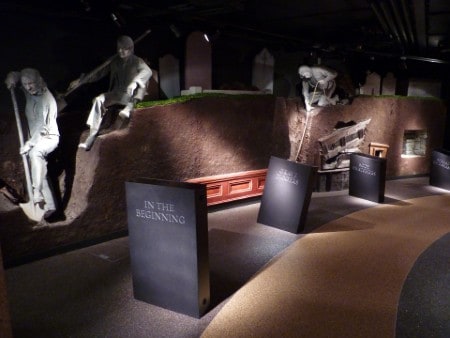
As you explore this exhibition, you get to learn about the people buried in the cemetery, what they owned, and what was sacred and dear to them.
Visitors also learn about the massive archive, dating back to the 1800s, that the Glasnevin Trust maintains.
Don’t miss out on the section about grave-robbing which was once quite prevalent in the city.
The ‘Religion Wall’ displays the different beliefs every religion has about the concept of ‘after life.’
The Milestone Gallery
The Milestone Gallery houses special exhibitions on key historical figures from Ireland, starting with Daniel O’Connell, who is also known as ‘The Liberator.’
Interactive Timeline
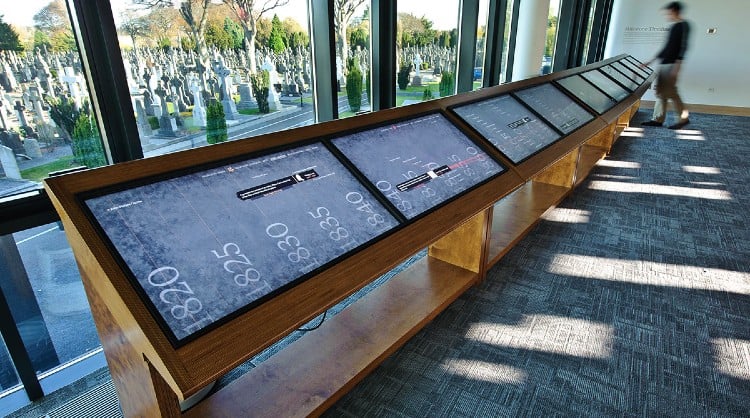
The 10-meter (33 feet) long Interactive Timeline is part of the Milestone Gallery and was launched in 2009.
The Timeline’s interface allows visitors to browse through a selection of 200 influential figures in Irish history.
Touching one of the personalities gives you a short bio, after which you can go on to know more about them by reading the full biography.
The Prospect Gallery
The Prospect Gallery has many photos of the most famous funerals and historical events at Glasnevin Cemetery.
You will also get to see funerary monuments and historic graves.
O’Connell tower
O’Connell tower is a tribute to Daniel O’Connell, the Irish political leader from the first half of the 19th century.
Standing at 55 meters (180 feet), it is Ireland’s tallest round tower.
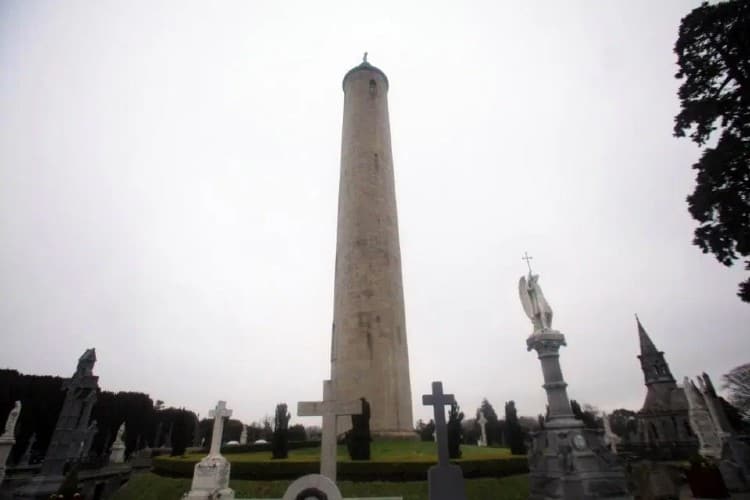
In 1971, a bomb detonated at the base of the Tower, after which it got closed down. After decades, the iconic landmark reopened to the public in April 2018.
Today, the Tower hosts an exhibition narrating the life of Daniel O’Connell and the history of the majestic Tower built in his honor.
Visitors can book a climb on this Tower, which takes approximately 30 minutes. Jump to the tickets section
Once you climb the 198 steps and reach the top, you get to enjoy stunning views of the Glasnevin Cemetery, the city of Dublin, Wicklow, and the Irish Sea.
Important: Kids younger than 8-year-olds aren’t allowed to go up the O’Connell Tower. An adult must accompany children aged 8 to 12, at all times.
Michael Collins’ Grave
Michael Collins was an Irish revolutionary and a major force in the early-20th-century Irish struggle for independence.
He was assassinated in August 1922 and buried at this cemetery.
Michael Collins’ is the most visited grave in Glasnevin.
The Cross of Sacrifice
The Cross of Sacrifice is a Commonwealth war memorial designed in 1918 by Sir Reginald Blomfield for the Commonwealth War Graves Commission.
As a practice, this memorial is present in Commonwealth war cemeteries containing 40 or more graves of soldiers.
Cross of Sacrifice was unveiled in Glasnevin Cemetery in July 2014 and ever since has become an attraction.
Gravediggers Pub
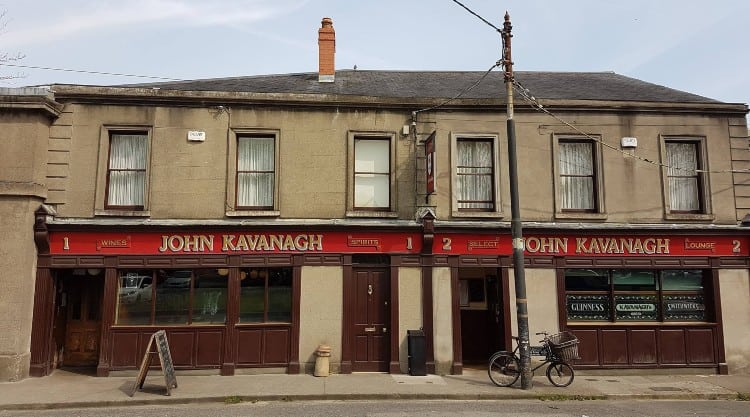
This pub was set up by John Kavanagh in 1833 and is built into the wall of Glasnevin Cemetery, in the picturesque Prospect Square.
Over the centuries, gravediggers have come to this pub for a few pints and some food after a hard night’s digging.
Today the John Kavanagh pub, which is also referred to as the ‘Gravediggers Pub,’ is being run by a seventh-generation Kavanagh, and tourists step in to get a feel of the old.
National Botanic Gardens
The National Botanic Gardens is a 19.5 hectares garden situated between Glasnevin Cemetery and the River Tolka, where it forms part of the river’s floodplain.
From the Glasnevin Cemetery, you can get to the Botanic Gardens for a stroll.
The linking gate is along the wall at the far side of Glasnevin Cemetery, Prospect Square entrance.
Tower Cafe
The Tower Cafe at Glasnevin is also known as the gateway between Glasnevin Cemetery and the National Botanic Gardens.
It is open from 9.30 am to 5 pm everyday and offers breakfast, quick bites, fast food, etc. Download Menu
The restaurant is wheelchair accessible, and visitors choose to either dine-in or take out.
Even though the restaurant’s capacity is 70, it gets a bit crowded at lunchtime.
Tip: Some tourists believe that food is expensive at the Tower Cafe.
Glasnevin Cemetery facts
1. Since the Glasnevin Cemetery opened in 1832, more than one and a half million people have been interred (buried) there. Before the Glasnevin, Irish Catholics had no cemeteries in which to bury their dead.
2. Glasnevin Cemetery Museum was opened in 2010 and is the world’s first cemetery museum.
3. Glasnevin Cemetery is home to one of the largest collections of Celtic crosses in the world. A Celtic crosses are unique in two ways – they have a ring of stone encircling the arms of the cross itself, and Christ gets displayed at the center of the stone circle.
4. Glasnevin Cemetery is officially known as Prospect Cemetery. This the Cemetery is surrounded on most sides by a Town named Prospect.
5. Maria Higgins was buried twice at Glasnevin Cemetery. The first time she was ‘buried’ as part of a scheme to get her inheritance, and her coffin only had bricks and sand. The second burial happened many years later when she actually passed away.
6. Father Francis Browne, the person because of whom we know how Titanic looked like, is buried in the Glasnevin Cemetery. Just before it set sail, Father Francis took lots of photographs of the cruise ship, its crew and passengers.
7. In 1911, one of the Glasnevin Cemetery guards spotted something colorful in the trees, and to scare it, shot in the general direction. As luck would have it, a beautiful bird fell to the ground with a thud. The same day a man called the Cemetery enquiring if anyone had seen his very valuable and rare macaw. When he came to know what happened, he sued the Cemetery for 100 pounds.
8. 1890 was the year of the Irish at Wimbledon (even though back then, Ireland was part of Great Britain). That year, the Irish tennis stars won the Ladies Singles, Men’s Singles, and the Men’s Doubles titles. Frank Stoker was the Men’s Doubles title winner along with Joshua Pim, and he would go on to win once again in 1893. This man, who besides playing tennis, was also an Irish international rugby player, and a dentist is buried in the Glasnevin Cemetery.
9. In 1879 Glasnevin Cemetery’s entrance was moved from Prospect Square to Finglas Road. Before they moved the access, they had to buy all the land opposite the cemetery because they didn’t want any businessman to open a pub. The cemetery was already facing issues with mourners being late for the funerals and landing up drunk.
10. Fr Michael Morrison, the man who witnessed the liberation of Bergen-Belsen concentration camp, is buried at this cemetery. During his stay at the camp, he witnessed unbelievable horrors, including cannibalism and mass graves. He missed meeting Anne Frank at the camp by a few weeks.
11. During the Irish War of Independence, the IRA used a coffin inside a Glasnevin Cemetery vault to store their weapons. They had to move former occupant Ann Hodgens to make room for the guns.
12. In 1932, Sydney Harbour Bridge was ready for inauguration, and a local Australian politician was selected to do the honors. But Irishman Francis de Groot felt only a member of the British royal family must open the bridge for the public. An upset and angry de Groot put on his Army uniform, borrowed a horse, and blended in with the cavalry guard of honor. At the right opportunity, he drew his sword, charged towards the red ribbon, and cut it, all the while shouting, “I declare this bridge open in the name of the decent and respectable people of New South Wales!”
De Groot was laid to rest at this Dublin Cemetery.
